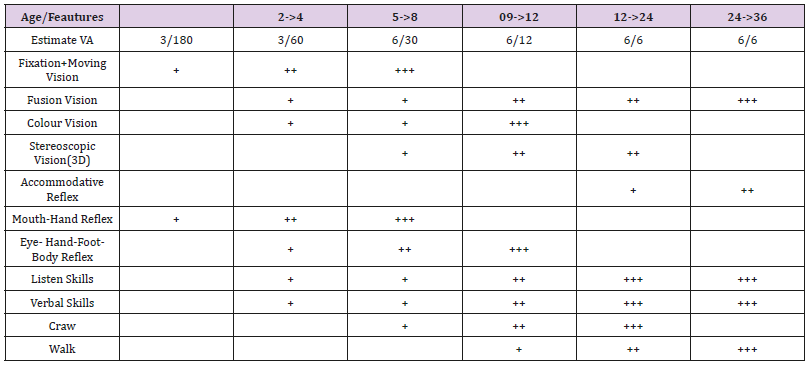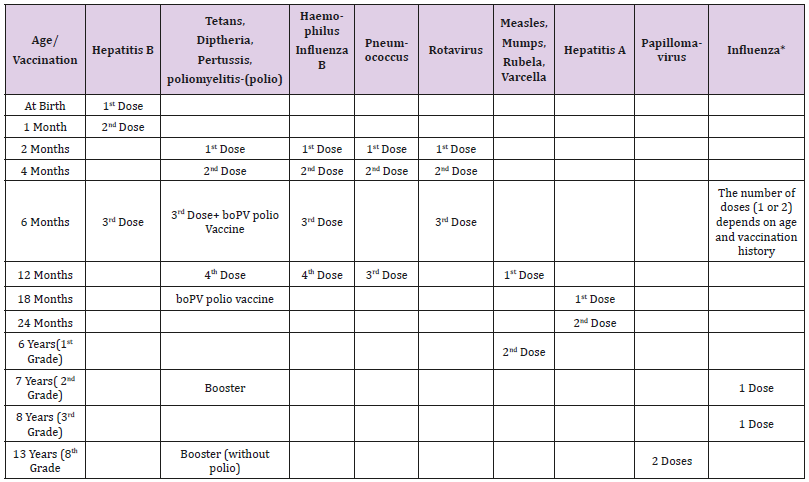Children and Infant’s Vision and Measure for Detecting Congenital Eye Diseases
Introduction
A baby’s vision goes through many changes during their first year of life. Knowing the milestones development of vision is what you can do to help your baby as well as can help you watch and enjoy your child’s visual development. The pediatrician / ophthalmologist/heath care staffs will check your infant’s vision to monitor these changes and make sure their vision is developing as it should. On this occasion a measure was proposed. The integration of vaccination program and vision follow up for detecting abnormal eye signs early by medical staffs and family is a measure at low cost. In developing countries because of lack of staffs as well as knowledge about their infants and children disease so many measures should be associated. This paper will review infant and children’s vision, some congenital eye diseases with abnormal eye signs, and an integrated measure with vaccination program is noted with some detail.
Infant and Children’s Vision
When the baby is born, the baby’s open eyes are contacted with you in the first time, it is a greatest moments. The visual system of a newborn takes some time to develop. In the first week of life, infants do not see much detail. Children look first in the world is not clear and unique in the shades of gray. It takes a few months to fully develop your child’s vision. A baby’s vision (Table 1) goes through many changes during their first year of life. Knowing the milestones that develop the vision is what you can do to help your baby. It can ensure your child is properly seen and fully enjoying their world. The pediatrician /ophthalmologist/heath care staffs will check your infant’s vision to monitor these changes and make sure their vision is developing as it should. Knowing what to expect can help you watch and enjoy your child’s visual development.
a. At birth, baby is adjusting to light and beginning to focus: An infant is very sensitive to bright light only with 380 lux, see something next to them 1 foot. Within a couple of weeks, as their retinas develop, a baby’s pupils widen and they can see light and dark ranges and patterns. At about one month, your baby may focus briefly on you but may still prefer brightly colored objects up to 3 feet away. The first “baby talk” is nonverbal and happens soon after birth. Your baby grimaces, cries, and squirms to express a range of emotions and physical needs, from fear and hunger to frustration and sensory overload.
b. Two months old, babies usually are able to follow a moving object with their eyes as their visual coordination improves.
c. Three months old, your baby may have enough eye and arm coordination at a nearby moving object. At three months old, your baby’s eyes should work together to focus and track objects.
Table 1: Infant’s Vision and other developments.

d. Fourth months old, baby developed eye - mouth - arm coordination.
e. Five months old, a baby’s ability to see how far an object is from them with depth perception, 3 dimensions (3D).
f. Six months old, a baby may recognize their parent and smile at them.
g. Seven months old enhances their eye-mouth-hand coordination.
h. Eight months old, babies generally start crawling at around and respond to own name.
i. Nine months old, babies can generally judge distance to grasp something with thumb and forefinger. Your baby’s eyes are probably their final color.
j. Ten months old, babies can crawl and start development of listen/verbal skill.
k. Eleven months old, babies are crawling well, develop depth perception. Visual acuity’s infant can be achieved 6/12.
l. Twelve months old, most babies are crawling and trying to walk twelve months old, most babies are crawling and trying to walk, to say some words.
m. By two years of age, a child’s eye-hand coordination and depth perception should be well developed. Children this age are highly interested in exploring their environment and in looking and listening. They recognize familiar objects and pictures in books and can scribble with crayon or pencil. Children develop of listen/ verbal skill well. Visual acuity’s infant can be achieved 6/6. Critical milestones for a baby learning to talk happen in the first three years of life, when a baby’s brain is rapidly developing. Toddler from one to 3 years old needs up to 12-14 hours a day of sleep. There’s a wide range for when children achieve a particular milestone. For example, children walk as early as 9 months or as late as 14 months. The American Academy of Ophthalmology and the American Association for Pediatric, Ophthalmology and Strabismus recommend the following exams:
a) Newborn: A newborn baby’s eyes should be examined and performed a red reflex test. An ophthalmologist should perform a comprehensive exam if the baby is premature or at high risk for medical problems for other reasons, has signs of abnormalities, or has a family history of serious vision disorders in childhood.
b) Infant: A second screening for eye health should be done by an ophthalmologist, pediatrician, family doctor or other trained health professional at a well-child exam between six months and the first birthday.
c) Preschooler: Between the ages of 3 and 3½, a child’s vision and eye alignment should be assessed
i. Visual acuity should be tested as soon as the child is old enough to cooperate with an eye exam using an eye chart or photo-screening. The testing will determine whether the child can focus normally at far, middle and near distances. Some children are farsighted but can also see clearly at other distances. Most children will not require glasses or other vision correction.
ii. If misaligned eyes (strabismus), “lazy eye” (amblyopia), refractive errors (myopia, hyperopia, astigmatism) or another focusing problem is suspected in the initial screening. It’s important to begin treatment as soon as possible to ensure successful vision correction and life-long benefits.
d) School age: Upon entering school, or whenever a problem is suspected, children’s eyes should be screened for visual acuity and alignment. Nearsightedness (myopia) is the most common refractive error in this age group and can be corrected with eyeglasses. If an alignment problem or other eye health issues is suspected, the child should have a comprehensive exam by an ophthalmologist [1].
Congenital Eye Diseases With Abnormal Eye Signs
According to a World Health Organization (WHO 2005) report, disease patterns tend to shift from infectious diseases to injuries, genetics, metabolic disorders. Congenital malformations of 16 countries through 4,228,718 births show an infant birth defect rate of 1.73%. In Vietnam, according to the 2015 Population and Housing Census, the longevity is 73.3 years old, the prevalence of birth is 2.2%, the birth rate of congenital deformities is 3%. At present, the rate of newly diagnosed children in Vietnam is just under 1%. The mortality of children of age 5 is 22.2/1.000 people [2]. One study on baby defects was diagnosed after birth on the basis of clinical and subclinical examination in 3 years 2001-2003 in the National Obstetric Hospital. The number of birth defects was 2.7 % [3]. Some congenital eye diseases are often seen such as: retinoblastoma, glaucoma, cataract, strabismus and refractive errors when the children grow up. The abnormal eye signs can be paid attention: retinoblastoma with proptosis and cat eye reflex, congenital cataract with white pupil, glaucoma with exophthalmos and strabismus with eyes misalignment [4,5]. Retinoblastoma is a malignant disease that not only destroys the visual function of the affected eye but can also threatening the life of young children. According to US statistics, one in every 15,000 to 30,000 children is born with the disease. Patients should have done ultrasound, CT scanner, magnetic resonance to determine the size and position of the tumor in the eye [6]. The incidence of retinoblastoma among neonates has been estimated at one per 34,000 births while more recent studies reported an incidence of one case in 15,000 to 20,000 live births [7].
Vaccination
Today, children in the United States routinely get vaccines that protect them from more than a dozen diseases such as measles, polio, tetanus, diphtheria, and pertussis (whooping cough). Most of these diseases are now at their lowest levels. Children must get at least some vaccines before they may attend school. Vaccines work best when they are given at certain ages. For example, children don’t receive measles vaccine until they are at least one year old. If it is given earlier it might not work as well. The Centers for Disease Control and Prevention publishes a schedule for childhood vaccines. In Vietnam, according to Dr Nguyen Tran Hien, Head of the Executive Board of the Vaccination Program t, Director General of the National Institute of Hygiene and Epidemiology, said that the vaccination program has lowered the mortality rate among children under five over the past 20 years, from 51.2% (1990) to 23% (2011); Infant mortality has decreased from 23% in 1990 to 12% in 2010.
Table 2: Table of Childhood Vaccination Plan.

Vaccination rates for all children under 1 year old are> 90% nationwide. This rate has steadily increased and since 1993 has been maintained at >90% at the provincial level [8]. Tuberculosis vaccination is only one dose, for one month after birth. List of 14 serious diseases that vaccines prevent their symptoms and possible complications: Diphtheria; Pertussis; Tetanus; Polio; Haemophilus influenzae type b infections; Mumps; Rubella; Varicella (chickenpox); Meningococcal infection; Pneumococcal infection; Hepatitis B; Influenza; Rotavirus and Measles. In Israel, all routine vaccines given at Tipat Halav family care centers and at schools is free of charge and plan Table 2 as follow [9].
An Integrated Measure
An integrated measure of vaccination program and follow-up vision for detecting child’s abnormal eye signs by medical staffs and family is proposed. In developed countries all services of child’s health care are available. In developing countries because of lack of staffs as well as knowledge about their infants and children disease so many measures should be associated for example between vaccination with eye care for detecting congenital eye diseases early. The earlier these diseases are detected, the more effective they are treated. The parent’s or relative’s infants and children have to pay attention about the eye signs mentioned above and:
a. To ask for medical staffs or health care staff for counseling infant‘s abnormal eye signs on the occasion of infant’s schedule of vaccination.
b. To photograph or take video about the abnormal signs of the child eyes by smarphone and talking with medical staffs in school or kindergarten when the children go to school. Working together to day, better results of health care in infant and children tomorrow will be obtained.
Conclusion
Knowing the milestones development of vision is what you can do to help your baby as well as can help you watch and enjoy your child’s visual development. This integration of vaccination program and vision follow up for detecting abnormal eye signs early by medical staffs and family is a measure at low cost. In developing countries because of lack of staffs as well as knowledge about their infants and children disease so many measures should be associated. The earlier these diseases are detected, the more effective they are treated. Working together to day, better results of health care in infant and children tomorrow will be obtained.
Rethinking the Treatment of Pathologic Scars-https://biomedres01.blogspot.com/2020/12/rethinking-treatment-of-pathologic-scars.html
More BJSTR Articles : https://biomedres01.blogspot.com


No comments:
Post a Comment
Note: Only a member of this blog may post a comment.